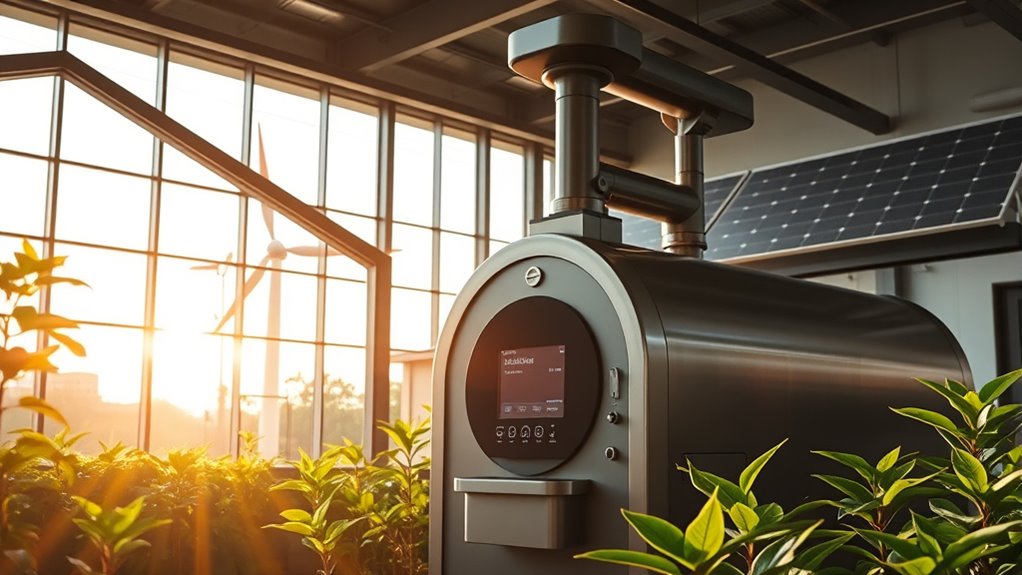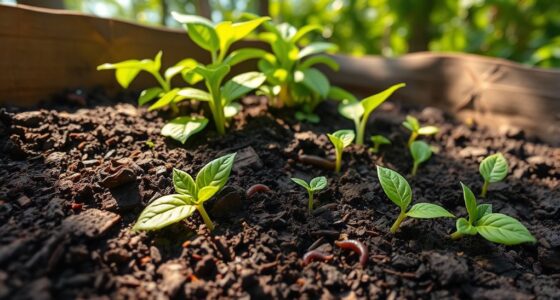To practice sustainable roasting, you can switch to renewable energy sources like solar or wind, reducing reliance on fossil fuels. Incorporate emission reduction technologies such as energy-efficient machinery and heat recovery systems to cut pollutants and save energy. Embracing innovations not only lessens your environmental footprint but also boosts resource efficiency. Exploring these solutions shows your commitment to responsible production — keep exploring to discover even more ways to elevate your sustainability efforts.
Key Takeaways
- Transitioning to renewable energy sources like solar and wind reduces emissions and enhances long-term sustainability of roasting operations.
- Implementing advanced combustion and energy-efficient machinery minimizes energy consumption and pollutant emissions.
- Waste heat recovery systems capture excess heat for additional use, improving energy efficiency and reducing environmental impact.
- Eco-friendly packaging and waste reduction strategies support resource management and ethical sourcing practices.
- Transparency in energy use and emission reduction efforts boosts consumer trust and sets industry standards for sustainable roasting.

Sustainable roasting is transforming the coffee industry by prioritizing eco-friendly practices and ethical sourcing. As a coffee roaster committed to sustainability, you recognize that your choices directly impact the environment. One of the most significant ways to reduce your footprint is by integrating renewable energy sources into your operations. Instead of relying on traditional fossil fuels, you can utilize solar, wind, or bioenergy to power your roasting facilities. This shift not only diminishes your dependence on non-renewable resources but also demonstrates your commitment to long-term environmental health. Switching to renewable energy is a proactive step toward emission reduction, helping you cut greenhouse gases that contribute to climate change. Every kilowatt of clean energy you use makes a tangible difference, and it aligns with the growing consumer demand for ethically produced coffee. Additionally, modern technology offers several tools for emission reduction, such as advanced combustion systems and energy-efficient machinery. These innovations optimize fuel usage and reduce the release of harmful pollutants during roasting. You can also implement waste heat recovery systems, capturing excess heat from the roasting process and repurposing it for other operational needs. This not only conserves energy but also lowers overall emissions. By monitoring your emissions closely and adopting best practices, you actively contribute to a cleaner environment. Your commitment to emission reduction underscores the importance of environmentally responsible production, setting a standard for others in the industry. Furthermore, sustainable roasting involves thoughtful management of resources beyond energy. You can choose eco-friendly packaging, reduce waste, and support fair trade practices that promote ethical sourcing. These efforts amplify your impact, ensuring that your commitment to sustainability extends through the entire supply chain. The adoption of renewable energy and emission reduction strategies also resonates with consumers who prioritize environmentally conscious brands. It creates a narrative of integrity and responsibility that strengthens your reputation and trustworthiness. Incorporating high-efficiency combustion systems can further improve your energy use and reduce emissions, making your operations even more sustainable.
Frequently Asked Questions
What Are the Latest Renewable Energy Sources Used in Roasting?
You’ll find that the latest renewable energy sources in roasting include solar integration and biofuel adoption. Solar panels are increasingly used to power roasting facilities, reducing reliance on fossil fuels, while biofuels derived from waste or plant materials offer a sustainable alternative for heat generation. By adopting these innovations, you can substantially lower emissions and improve your roasting operation’s environmental impact. These advancements help make your process more eco-friendly and energy-efficient.
How Do Emission Levels Compare Across Different Roasting Technologies?
You’ll find that emission levels vary markedly across roasting technologies. Emission reduction is most effective with advanced methods like fluid-bed or convection roasters, which produce fewer pollutants than traditional drum roasters. When comparing these technologies, you’ll see that newer systems often feature better insulation and energy recovery, leading to lower emissions. So, choosing the right technology can make a big difference in your sustainability efforts and environmental impact.
Are There Certifications for Sustainable Roasting Practices?
Back in the day, people believed everything was perfect; now, you know better. Yes, there are certifications for sustainable roasting practices. Certification standards like Organic, Fair Trade, and Rainforest Alliance guarantee eco-friendly methods. Eco label programs help consumers identify environmentally responsible choices. These certifications promote transparency and accountability, encouraging roasters to adopt greener practices and reduce their environmental impact.
What Is the Cost Impact of Adopting Green Roasting Methods?
Adopting green roasting methods can increase your costs initially due to investment challenges and the need for specialized equipment. However, a thorough cost analysis often reveals long-term savings through energy efficiency and reduced emissions. While upfront expenses may seem high, embracing sustainable practices can boost your brand’s reputation and appeal to eco-conscious consumers, ultimately balancing out the costs and making your roasting process more environmentally friendly and economically viable.
How Can Consumers Identify Sustainably Roasted Coffee?
You can identify sustainably roasted coffee by looking for certifications like Fair Trade and Organic on the packaging. These labels indicate that the coffee was produced with environmentally friendly practices and fair labor standards. Additionally, check for transparency from the roaster about their sourcing and roasting methods. By choosing certified products and supporting brands committed to sustainability, you guarantee your coffee choices contribute to a healthier planet.
Conclusion
By embracing sustainable roasting, you’re not just making a small change—you’re revolutionizing the entire coffee world! Imagine slashing emissions, saving energy, and leading the charge toward a greener planet with every cup you brew. Your choices could spark a global movement so powerful, it transforms how humanity drinks coffee forever. So, take action now—because this isn’t just about roasting beans; it’s about saving the Earth, one sustainable sip at a time!









